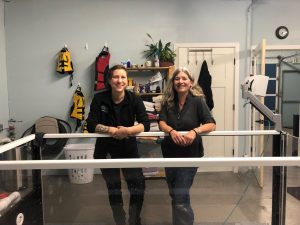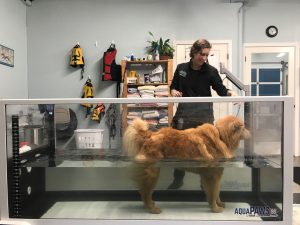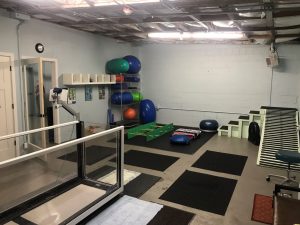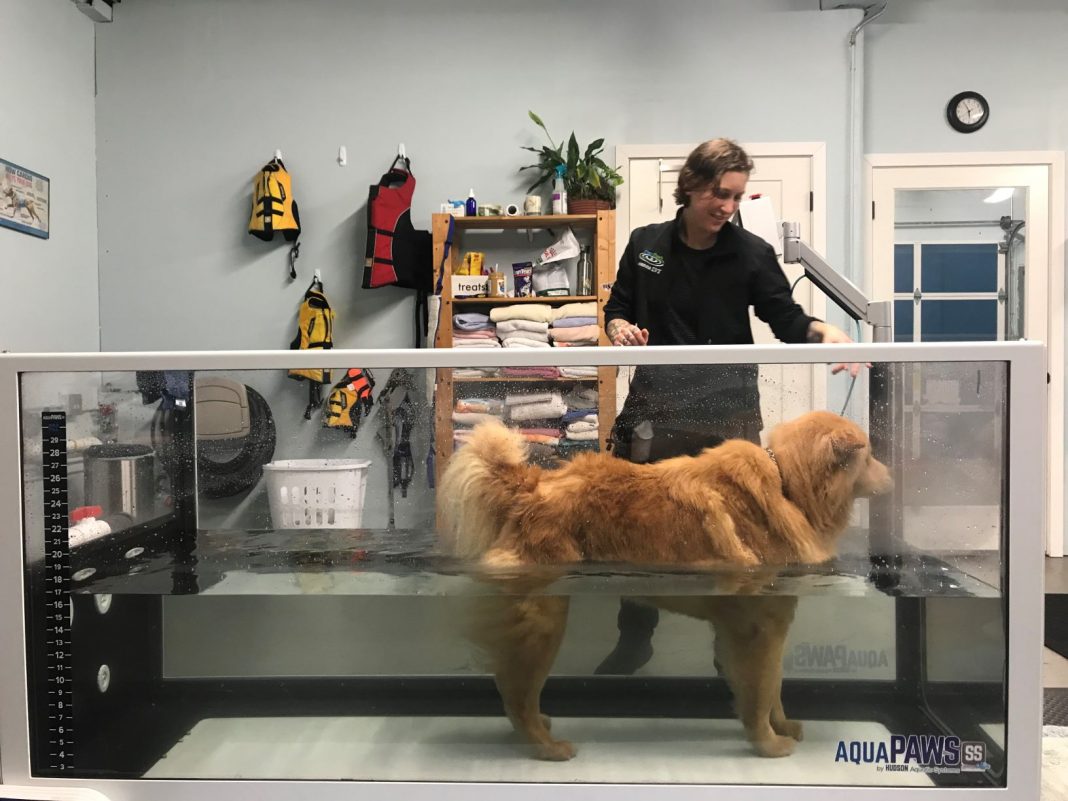Physical therapy is usually associated with pain, determination and a lot of hard work. Not for the dogs at Four Paws Animal Rehabilitation. They offer physical therapy and rehabilitation for post-surgery, geriatric and even nationally competing dogs.
 Four Paws Animal Rehabilitation was founded in 2008 by Tumwater Veterinary Hospital’s Doctor Bennet. A year ago, the pet rehabilitation center transitioned to the meticulous care and attention of Savanna Skelton and Dana Gordon. Between them, they have 15 years of animal care experience. Gordon is a small animal massage practitioner and Skelton is a licensed veterinary technician.
Four Paws Animal Rehabilitation was founded in 2008 by Tumwater Veterinary Hospital’s Doctor Bennet. A year ago, the pet rehabilitation center transitioned to the meticulous care and attention of Savanna Skelton and Dana Gordon. Between them, they have 15 years of animal care experience. Gordon is a small animal massage practitioner and Skelton is a licensed veterinary technician.
Animal Hydrotherapy
Four Paws Animal Rehabilitation is the only clinic with an aquatic treadmill within 60 miles. Gordon and Skelton use a technique called hydrotherapy to treat dogs that are recovering from injuries or surgery. In the past it would be typical for dogs to be prescribed anti-inflammatories, which only treats a symptom, not the root of the problem. Dogs would be confined to the pain in their bodies and not able to properly heal. The healing process for animals is very similar to ours. If humans do not actively participate in physical therapy as old age approaches, or especially post-surgery, bodies and joints will grow stiffer and stiffer. The same is true for dogs. “This therapy addresses balance, stability, conditioning, strength and gait,” Skelton said.

Sitting in the middle of their warmly lit rehab office is a see-through glass tank. On the bottom, a treadmill runs smoothly. The treadmill serves as one of the key components to the dogs healing process, which helps them transition out of rehabilitation with less inflammation and stiffness. “Sixty percent of the dog’s weight is unloaded once they begin moving,” Gordon says. “10 minutes in the tank equates to one hour on land.”
The tank is filled with warm water, which relaxes joints and muscles. It fills up to the dog’s chest lifting the majority of their weight off their legs. The water also presses against muscles, helping reduce any swelling while creating a significant amount of resistance to ensure a proper work out. The resistance can increase or decrease depending on the speed of the current applied. The repetitive movement combined with the very limited pain enables healing to happen much quicker. “A lot of the major healing work is neurological,” explains Gordan. “The brain is actively retraining the muscular movements.”
“It doesn’t take the dogs long to figure out this is a very safe and fun place to be,” adds Skelton. “Therapy continues even after the dogs have left. We incorporate the owners into the healing process as well. We show them exercises their dogs can be doing at home.”

Each dog varies in its need to attend physical therapy appointments. Inside the clinic is every tool required to pinpoint the muscle groups and target them for exercise and stretching. Certain dogs coming into the clinic have unknown stiffness issues requiring multiple visits in order to locate the problem. Some come a few times and begin the path to recovery quickly. Others require a little more attention. Those dogs remain for routine workouts and scheduled flexibility appointments. This occurs due to muscle deterioration and atrophy from underuse. The less muscles are used, the less muscle mass an animal has.
One of the main reasons physical therapy is so successful inside the tank is simply because outside of it no healing or healthy stress would be put on the joints and muscles. In addition, gaining muscle mass takes far more time than it does to lose it.

During a dog’s weekly session an owner can expect their rehabilitating pup to walk the treadmill, get a massage, practice core workouts, stabilization routines, and walk up and down stairs. Stabilization exercises are essential in the healing process as well. It touches on multiple muscles at once and applies stress to the muscles in ways it will be used for day to day use. The therapy sessions combined with ample treats has created a very warm and welcoming environment for every dog that comes through. “Dogs know when they are coming in for appointments. They know when they are approaching the clinic and get excited way before coming in,” Skelton says.
Massaging the dogs is crucial in the healing process as well. Not only is it therapeutic, but it shows clearly where muscle mass has grown or declined. The dogs scheduled for appointments will alternate between time in the tank and time outside getting massaged. “The entire process is individualized.” Says Skelton. “Pinpointing the muscles can get tricky so massaging the dogs and feeling for declines or growth in muscle mass is very important.”
For more information, visit the Four Paws Animal Rehabilitation website.
Four Paws Animal Rehabilitation
414 Legion Way SE, Olympia
360-753-7297


















































